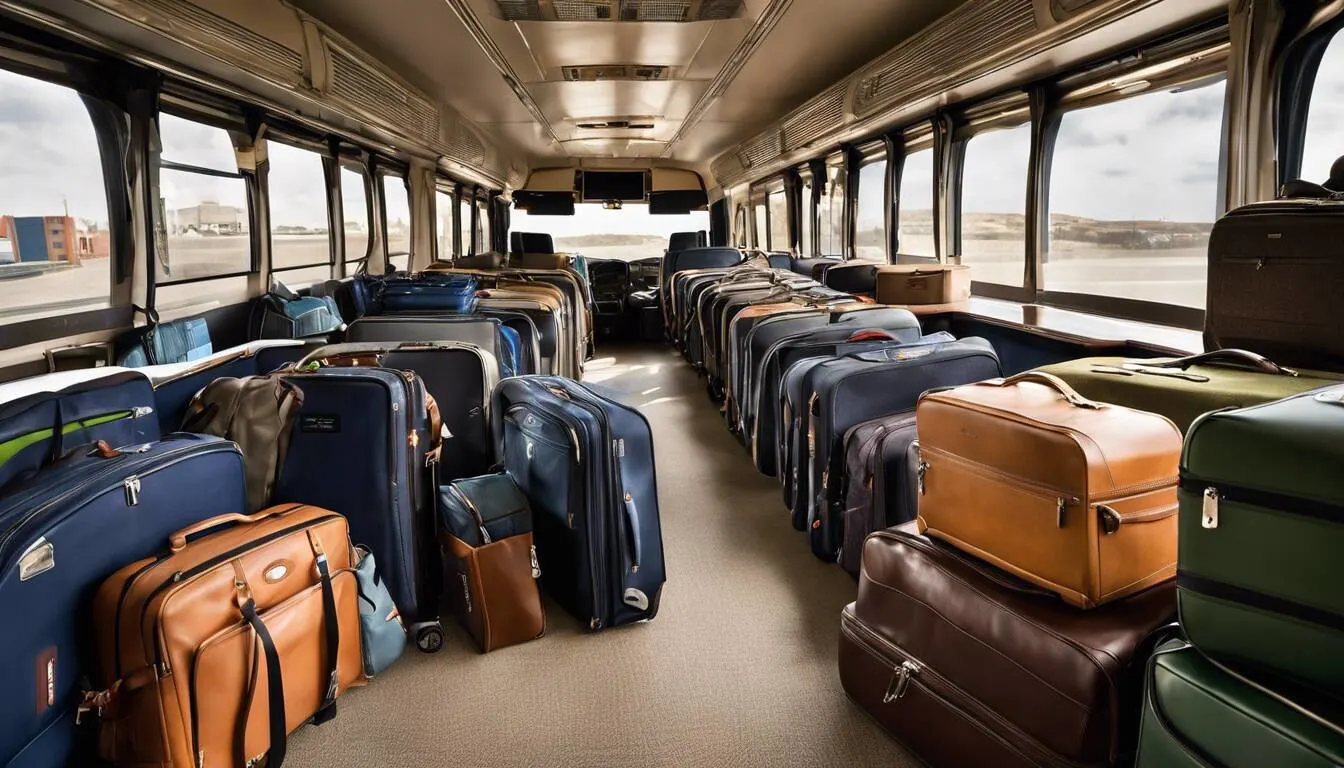Got your ticket for a cross-country adventure on Greyhound? Before you start packing, it’s vital to understand the Greyhound bus luggage restrictions. Get it right, and you’ll be cruising comfortably down the open road; get it wrong, and you risk delays or even denied boarding. Dive into our guide where we demystify the ins and outs of what to pack and what to leave behind ensuring your Greyhound journey is smooth and hassle-free. Don’t let excess baggage slow down your trip — stick with us and pack like a pro!
When traveling on a Greyhound bus, you can bring one carry-on bag that must fit under your seat or in the overhead compartment. Additionally, you can bring one bag into the baggage compartment before boarding. It is recommended to label all baggage with your name, address, and telephone number. Suitcases, backpacks, duffel bags, and trunks are recommended for baggage, while toolboxes, securely tied cardboard boxes, plastic bags, paper bags, and items protruding from your baggage are not recommended. Fees may apply for excess or bulky baggage. Strollers, car seats, wheelchairs, walking aids, and certain sports equipment like golf clubs or skis can also be accommodated with specific guidelines provided by Greyhound. Pets are not allowed on buses except for service animals.

Table of Contents
Greyhound Bus Carry-On and Baggage Policy
Before departing on a Greyhound bus, it’s essential to familiarize yourself with their luggage restrictions. Doing so ensures that you carry only what’s necessary without incurring additional fees or being turned away at the station.
As per the company’s policy, passengers are permitted one carry-on bag, which should fit under their seats or in an overhead compartment. This bag should be small enough to allow other travelers to fit their luggage without hassle. Additionally, passengers can bring one more bag, which should be stored in the baggage compartment before boarding.
It’s important to know what types of baggage are permitted and what isn’t to avoid confusion.
Size and Weight Limitations
Greyhound has specific guidelines for carrying luggage on board its buses. These guidelines help ensure that each passenger travels safely and comfortably while avoiding unsafe situations while handling baggage.
The permissible dimensions for luggage intended for storage in bus compartments are up to 62 linear inches (length + width + height) and must not exceed 50 pounds. For carry-ons that go beneath the seat or in the overhead compartment, maximum dimensions are limited at 25 linear inches and total weight should not exceed 25 pounds.
Excess baggage must be reserved online in advance as it is subject to availability. Doing so guarantees space on-board bus compartments and allocates an extra fee depending on size and weight.
While fragile goods might be allowed on board the bus as part of your carry-on, it is advisable to keep them safe by ensuring they’re packed securely and appropriately.
A suitable type of baggage could include suitcases, backpacks, duffel bags, trunks – all easily stored in the compartments provided. On the other hand, cardboard boxes tied securely might be highly discouraged as they may unintentionally open when placed among numerous bags in the storage area.
Now that we have covered Greyhound’s luggage restrictions, it’s essential to highlight what types of things are permissible and impermissible items on board.
Permissible and Impermissible Items
Greyhound allows one carry-on bag to be stored under your seat or in the overhead compartment. Additionally, a stored baggage can be brought into the baggage compartment before boarding the bus. It is advised to label all bags with your name, address and phone number. However, Greyhound has strict guidelines regarding what items are permissible inside these bags. Recommended types of baggage include suitcases, backpacks, duffel bags and trunks. Examples of impermissible items include toolboxes, cardboard boxes securely tied, plastic or paper bags, and items sticking out of your baggage. If you want to bring along excess baggage which includes fragile items sports equipment or musical instruments then you must book it online in advance and pay the varying excess baggage fees.
Travel Essentials for Greyhound Bus Trip
Embarking on a long journey can sometimes be daunting but here are some travel essentials that will help make your Greyhounds trip more comfortable and less stressful.
Packing a sweatshirt, light jacket, or sweater is ideal since buses tend to maintain cooler temperatures. A neck pillow or a tiny inflatable pillow will provide you with enough comfort while sleeping on board. Also, earplugs can help you sleep soundly especially if other passengers talk for hours on end. For refreshments always carry a refillable water bottle since Greyhound delightfully offers bottled water throughout the journey. In addition to food purchases during pit stops, you can also carry non-perishables like protein bars, granola bars, dried fruit, or nuts to snack on during the trip.
A good book or tablet filled with music or movies can keep you entertained throughout the journey. Ensure that fully charged electronic devices are kept handy along with chargers in case charging ports might not work as expected.
Wi-fi may not always be available so downloading Netflix shows would come in handy.
While there is ample space above and below the seats for your luggage, using a smaller bag will be convenient since a roomy bag might not fit in the overhead storage compartments. Also, since Greyhound does not allow pets except for service animals, to avoid unnecessary distractions on board, you may have to avoid bringing along your furry friends.
More importantly, appropriate attire makes the journey more comfortable. Some good options include wearing comfortable clothes that are easy to move around in such as loose-fitting pants or jeans with a t-shirt or sweatshirt depending on the season. Be sure to pack sturdy walking shoes or sneakers since rest stops may require some walking.
Appropriate Attire and Consumables
When traveling by Greyhound bus, your attire should be comfortable and practical. Opt for breathable clothing that you can relax in over the course of long journeys. An extra layer like a sweater or jacket can also prove useful during colder weather conditions.
When choosing consumables to bring along on your journey, it’s wise to account for any dietary restrictions you may have. Also, remember to pack non-perishable food items such as nuts, granola bars, and fruits. For longer trips, hydrate often and carry water bottles or liquid refreshments such as juice boxes.
If you’re planning on consuming alcohol onboard, be sure to check Greyhound’s policy beforehand as they may differ from state laws.
- When traveling by Greyhound bus, make sure to dress in comfortable and practical attire, bringing layers for colder weather. Pack non-perishable snacks and drinks to stay nourished during your journey, taking into account any dietary restrictions. Check Greyhound’s policy on alcohol consumption before bringing any onboard.
Comfort and Personal Belongings
The bus journey experience with Greyhound can span several hours or more across different stops. So it’s essential that your personal belongings are carefully considered to ensure maximum comfort throughout the trip.
Carry along items like neck pillows, blankets, earplugs alongside personal entertainment options like books, music players, or tablets to keep yourself occupied.
Based on Greyhound’s restrictions for storing baggage, recommended types of baggage include suitcases, backpacks, duffel bags, and trunks. It is also advised that you label all baggage with your name, address, and telephone number in case of mishandling.
When packing personal hygiene items like toiletries and medication always store them in secure plastic bags to prevent leaks contaminating other clean areas in your bag.
It is important to note that bulky baggage is allowed with a maximum dimension of 95 inches (width + length + height). One bulky bag per passenger is permitted with corresponding fees ranging between $30 – $50 depending on distance traveled.
Overall when packing your personal belongings avoid items that might protrude or harm others around you. Greyhound recommends avoiding items such as toolboxes, securely tied cardboard boxes, plastic bags, paper bags, and items protruding from your baggage.
It is particularly crucial to double-check for banned items, especially in a world where security risks are deemed critical. Smoking paraphernalia, weapons of any kind, illegal drugs, and hazardous materials are all prohibited on Greyhound coaches.
Remember that packing for a long bus journey is like preparing for a long swim marathon; pack necessary items that provide comfort and minimize risk not only to yourself but also to fellow travelers.
Overview of Greyhound Bus Facilities
Greyhound is a major intercity bus provider that serves over 2,700 destinations across North America journeying over 18 million miles yearly. As one of the oldest and most extensive bus companies in the country, they prioritize passenger satisfaction and comfort. Greyhound has been a long-time favorite for budget-conscious travelers. While air travel can be expensive, the iconic buses offer an affordable way to traverse the continent.
The Greyhound facilities are spacious and equipped with all necessary amenities, including comfortable seating arrangements, charging ports for electronic gadgets, Wi-Fi services – which varies based on location – and restrooms. These comforts make it easier for passengers to enjoy their journeys. Furthermore, they continually implement enhanced safety protocol measures like deep cleaning and proper ventilation mechanisms.
With such vast locations, facilities may differ slightly from one terminal to another. However, passengers should have access to all amenities ensuring comfortable journeys regardless of their destination.
Now we can focus on one primary concern that often perplexes passengers: Greyhound’s baggage policy.
Addressing Additional Baggage Fees
Travelling by bus requires strategic packing due to limited spaces provided within the compartments. Therefore, adhering to Greyhound’s baggage policy becomes a crucial aspect. Although space is tight, participants are allowed specific baggage items but not without restrictions.
It’s important to carefully review Greyhound’s luggage policy before preparing baggage as additional bags or bulky bags can be added when booking tickets or at a later stage via Manage My Booking online portal.
While utmost care should be taken not to exceed these limits, extra or oversized bags may incur additional fees ranging between $19.99 to $60.00 USD/$19.99 – $60 CAD/ MXN 299.99-1,200/MXNand CLP 2,190 to 6,000 CLP depending on various factors such as route, time of travel, and method.
It’s recommended to book additional baggage as early as possible due to limited space within the bus. More information about Greyhound’s baggage policies and pricing can be found in the terms and conditions on their website.
As such, it’s essential always to check and adhere to Greyhound’s baggage policy since overpacking may lead to additional fees or rejected luggage. However, cautious packing and following these restrictions will ensure a comfortable journey without any last-minute surprises.
- According to Greyhound, passengers are permitted one carry-on bag that must be kept with them at all times – this is part of their standard policy as of 2022.
- A separate baggage compartment allows for one additional piece of luggage per passenger at no extra charge, as recorded by the company’s baggage guidelines.
- While specific dimensional data is unavailable, Greyhound stipulates that bulky baggage – bags with a total dimension (length + width + height) exceeding 95 inches – is allowed per passenger, subject to additional fees.
